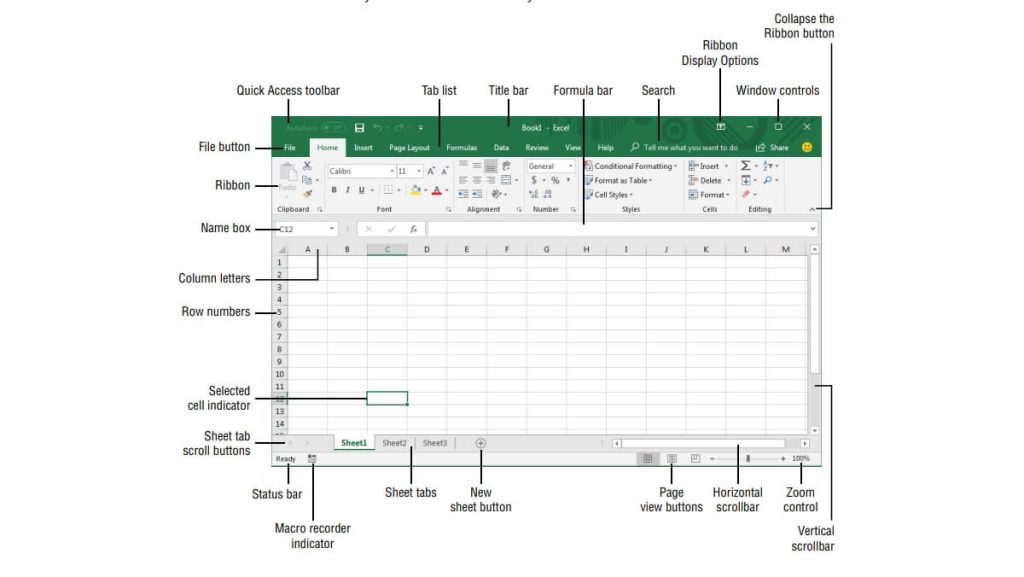Introduction to Microsoft Excel & Parts of the Excel Screen
Introduction to Microsoft Excel: Microsoft Excel is one of the most widely used spreadsheet software in the world. It has become a standard tool in the business world for analyzing and manipulating data. It is an essential software for anyone who works with numbers or data. In this article, we will introduce you to Microsoft Excel and how to use it effectively.
What is Microsoft Excel?
Microsoft Excel is a spreadsheet software developed by Microsoft Corporation. It is used to store, organize, and manipulate data in a tabular form. The data can be in the form of numbers, text, or formulas. Excel has powerful tools to perform complex calculations, create charts and graphs, and analyze data. Excel is a part of the Microsoft Office suite of applications and is available for both Windows and Mac.
Excel Interface: Introduction to Microsoft Excel
The Excel interface consists of a ribbon, a toolbar, and a worksheet. The ribbon contains several tabs that group commands and functions. The toolbar contains quick access icons for commonly used commands. The worksheet is where you enter and manipulate data.
Getting Started with Excel
To start using Excel, you need to create a new workbook. A workbook is a file that contains one or more worksheets. To create a new workbook, click on the File tab and select New. You can choose a blank workbook or one of the available templates.
Entering Data
To enter data into a worksheet, simply click on a cell and start typing. You can enter numbers, text, or formulas. You can also copy and paste data from other sources. Excel has several built-in functions and formulas that you can use to perform calculations.
Formatting Cells
You can format cells to change the appearance of the data. You can change the font, size, color, and alignment of the text. You can also apply number formats to display data in a specific format, such as currency or percentage. You can also apply conditional formatting to highlight cells that meet certain criteria.
Working with Formulas and Functions
Formulas and functions are the heart of Excel. They allow you to perform complex calculations and manipulate data. Formulas are equations that perform calculations on data in the worksheet. Functions are pre-built formulas that perform specific calculations. Excel has over 400 functions that you can use to perform a wide range of calculations.
Creating Charts and Graphs
Excel has powerful tools to create charts and graphs to display data visually. You can choose from several chart types, such as bar charts, line charts, and pie charts. You can also customize the chart elements, such as the title, axis labels, and legend.
Analyzing Data
Excel has several tools to analyze data. You can sort and filter data to view specific subsets of data. You can also use pivot tables to summarize and analyze data. Pivot tables allow you to group and aggregate data to perform calculations.
Sharing Workbooks
You can share workbooks with others to collaborate on data analysis. You can protect a workbook with a password to prevent others from making changes. You can also track changes made by others and accept or reject them.
Excel Add-Ins
Excel has several add-ins that extend its functionality. Add-ins are software programs that integrate with Excel to provide additional features. Some popular add-ins include Power Query, Power Pivot, and Solver.
Parts of the Excel Screen: Introduction to Microsoft Excel
Microsoft Excel is a powerful spreadsheet software that has become an essential tool in many businesses and industries. To effectively use Excel, it’s important to familiarize yourself with the different parts of the Excel screen. In this article, we will introduce you to the key components of the Excel screen and their functions.

- Ribbon: a set of tabs and icons that contain various commands and tools for working with Excel
- Quick Access Toolbar: a customizable toolbar located above the ribbon that contains frequently used commands
- Formula Bar: displays the contents of the active cell, including formulas and text
- Workbook: a file that contains one or more worksheets
- Worksheet: a grid of cells that is used to enter and manipulate data
- Column and Row Headers: columns are identified by letters at the top of the worksheet, while rows are identified by numbers on the left side of the worksheet
- Cell: the intersection of a row and a column on the worksheet grid
- Name Box: displays the cell reference of the active cell, such as A1 or B12
- Status Bar: displays various information about the worksheet, such as the current cell mode and the sum of selected cells
- Scroll Bars: allows you to navigate through large worksheets or to scroll to a specific area of the worksheet
- Active Cell: the currently selected cell
- Cell Address: the unique identifier of a cell, such as A1 or B12
- Fill Handle: a small square at the bottom-right corner of a selected cell that can be dragged to fill adjacent cells with a series or pattern
- AutoFill: a feature that allows you to quickly fill cells with a series or pattern based on the content of adjacent cells
- Format Painter: a tool that allows you to copy formatting from one cell to another
- Conditional Formatting: a feature that allows you to apply formatting to cells based on specific conditions
- Sort: a feature that allows you to sort data in a range of cells based on one or more criteria
- Filter: a feature that allows you to display only the rows of data that meet specific criteria
- PivotTable: a tool that allows you to summarize and analyze large amounts of data in a table format
- PivotChart: a tool that allows you to create visual representations of data in a PivotTable
- Chart: a tool that allows you to create visual representations of data in a variety of chart types
- Sparklines: a tool that allows you to create small, inline charts that display trends or patterns in data
- Page Layout View: a view that displays how the worksheet will look when printed
- Normal View: the default view that displays the worksheet with all of its elements
- Freeze Panes: a feature that allows you to lock specific rows or columns in place so that they remain visible as you scroll through the worksheet
- Split Panes: a feature that allows you to divide the worksheet into separate panes that can be scrolled independently
- Zoom: a feature that allows you to adjust the magnification level of the worksheet
- Themes: a feature that allows you to apply a set of formatting styles to the worksheet
- Page Setup: a feature that allows you to set various page settings, such as margins, orientation, and paper size
- Headers and Footers: areas at the top and bottom of a printed page that can contain page numbers, titles, and other information
- Print Area: a feature that allows you to specify a range of cells to be printed
- Print Titles: a feature that allows you to specify rows or columns to be repeated on each printed page
- Comments: a feature that allows you to add notes or annotations to a cell
- Protection: a feature that allows you to lock cells, worksheets, or workbooks to prevent unauthorized changes
- Validation: a feature that allows you to limit the data that can be entered into a cell based on specific criteria
- Data Bars: a feature that allows you to add conditional formatting in the form of colored bars to a range of cells
- Icon Sets: a feature that allows you to add conditional formatting in the form of icons to a range of cells
- Formulas: mathematical expressions that perform calculations on data in cells
- Functions: pre-built formulas that perform specific calculations or tasks
- Insert Function: a tool that allows you to search for and insert a function into a cell
- AutoSum: a tool that allows you to quickly add up a range of cells
- Absolute and Relative Cell References: different ways of referring to cells in a formula, where absolute references always refer to the same cell and relative references adjust as the formula is copied to other cells
- Range: a selection of cells that can be used in formulas or other features
- Merge and Center: a feature that allows you to combine multiple cells into one cell and center the content
- Wrap Text: a feature that allows you to display long text in a cell by wrapping it to multiple lines
- Orientation: a feature that allows you to change the angle of text or the orientation of the cell
- Borders: a feature that allows you to add lines or borders around cells or ranges of cells
- Fill Color: a feature that allows you to fill cells with a specific color
- Font: a feature that allows you to change the appearance of text in a cell, such as font style and size
- Number Formatting: a feature that allows you to change the way numbers are displayed in a cell, such as currency or date format.
- These are just a few of the many parts of the Excel screen that users should be familiar with. By understanding the various tools and features of Excel, users can maximize their productivity and efficiency when working with data and spreadsheets.
Conclusion: Introduction to Microsoft Excel
Microsoft Excel is a powerful spreadsheet software that is essential for anyone who works with numbers or data. It has powerful tools to perform complex calculations, create charts and graphs, and analyze data. We hope this introduction has given you a good understanding of Microsoft Excel and its capabilities.



Leave a Comment